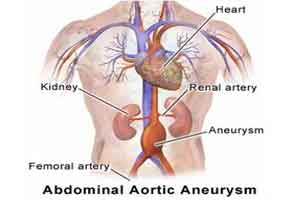- Home
- Editorial
- News
- Practice Guidelines
- Anesthesiology Guidelines
- Cancer Guidelines
- Cardiac Sciences Guidelines
- Critical Care Guidelines
- Dentistry Guidelines
- Dermatology Guidelines
- Diabetes and Endo Guidelines
- Diagnostics Guidelines
- ENT Guidelines
- Featured Practice Guidelines
- Gastroenterology Guidelines
- Geriatrics Guidelines
- Medicine Guidelines
- Nephrology Guidelines
- Neurosciences Guidelines
- Obs and Gynae Guidelines
- Ophthalmology Guidelines
- Orthopaedics Guidelines
- Paediatrics Guidelines
- Psychiatry Guidelines
- Pulmonology Guidelines
- Radiology Guidelines
- Surgery Guidelines
- Urology Guidelines
Routine screening for abdominal aortic aneurysm offers no benefit : Lancet

According to a latest Swedish cohort study of more than 130000 men, Harms of screening for an abdominal aortic aneurysm may outweigh benefits. Screening for abdominal aortic aneurysm which can cause sudden death if it ruptures, may not substantially reduce deaths from the condition. The findings of the study appear in The Lancet.
The authors estimated how many deaths were avoided as a result of screening, how many people were overdiagnosed, and how many people were treated when they did not need to b.eThe results of study question the need for the screening, which is also conducted in the UK and USA. In recent years, the number of cases of the abdominal aortic aneurysm has decreased significantly, which may alter the benefits and harms of the screening.
Routinely, screening for an abdominal aortic aneurysm is offered to men when they turn 65 years old. It involves an ultrasound scan of the abdomen to measure the size of the aorta. Men who have an aorta that is 30 millimeters wide or more are diagnosed with an abdominal aortic aneurysm and monitored regularly. Men with an aorta wider than 55 mm are offered preventative surgery.
Many a time abdominal aortic aneurysm is detected that would never have caused symptoms in a person’s lifetime, nor caused their death. This leads to unnecessary psychological distress, and mean that people undergo needless surgery. Moreover, the surgery for an abdominal aortic aneurysm is a complex operation in which the swelling of the major artery in the abdomen is replaced with a graft and carries a risk of serious complications such as stroke, myocardial infarction, amputation, renal failure, and even death.
In the present study, 25265 men aged 65 years or older who were invited to screening between 2006-2009, and 106087 men who were not invited for screening but otherwise similar (matched control group). The researchers calculated how many men were diagnosed with an abdominal aortic aneurysm, how many underwent surgery, and how many men died from the condition. They also looked at overall trends for these factors for all men aged 40-99 years in Sweden, between 1985 and 2015.
Between 2000-2015, mortality from abdominal aortic aneurysm declined by 70% across Sweden (from 36 to 10 deaths per 100000 men aged 65-74), with rates remaining similar in men who were and were not screened. In addition, screening did not substantially reduce mortality, with an estimated two deaths avoided for every 10000 men screened six years after screening. The difference was not statistically significant.
It was found that the screening was associated with significant harm from overdiagnosis and unnecessary treatment – six years after screening, 49 in every 10000 men screened were likely to have been overdiagnosed, and 19 of these men were likely to have undergone needless surgery.
The authors, therefore, concluded that abdominal aortic aneurysm screening had only a minor effect on mortality, and instead suggest that the lower mortality from an abdominal aortic aneurysm may be caused by declining smoking rates.
The researchers warned that the harms of screening may outweigh the benefits, and question its continued use. They also note that many cases are identified outside of the screening programme, through opportunistic testing and identification.
“Previously, the balance between the benefits and harms of screening programmes for abdominal aortic aneurysm was unclear as the major harms had not been adequately considered. Our new findings suggest that this screening programme may be outdated because the number of deaths from abdominal aortic aneurysm has been greatly reduced, likely due to lower smoking rates,” says lead author Dr. Minna Johansson, University of Gothenburg, Sweden.
The results from this study may be applied in countries which strictly follow the practice of routine screening for an abdominal aortic aneurysm.

Disclaimer: This site is primarily intended for healthcare professionals. Any content/information on this website does not replace the advice of medical and/or health professionals and should not be construed as medical/diagnostic advice/endorsement or prescription. Use of this site is subject to our terms of use, privacy policy, advertisement policy. © 2020 Minerva Medical Treatment Pvt Ltd